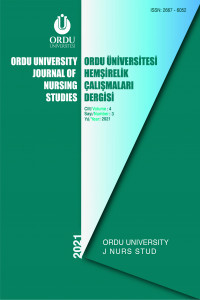Hemşirelik Öğrencilerinde Algılanan Stres, Başetme ve Merhamet Yorgunluğu
algılanan stres, hemşirelik öğrencisi, Merhamet yorgunluğu, stresle başetme
Perceived Stress, Coping and Compassion Fatigue in Nursing Students
Compassion fatigue, nursing student, perceived stress, coping with stress,
___
- Adams RE, Boscarino JA, Figley CR. (2006). Compassion fatigue and psychological distress among social workers:A validation study. American Journal of Orthopsychiatry, 76(1), 103-108. https://doi.org/10.1037/0002-9432.76.1.103
- Admi H, Moshe-Eilon Y, Sharon D, Mann M. (2018). Nursing students' stress and satisfaction in clinical practice along different stages: A cross-sectional study. Nurse Education Today, 68, 86-92. https://doi.org/10.1016/j.nedt.2018.05.027
- Andrew DPS, Pedersen PM, McEvoy CD. (2011). Research Methods in Sport Management. Champaign: Human Kinetics, 203-207.
- Ashghali FM, Ghaffari F, Oskouie F, Zagheri TM. (2017). Attrition among Iranian nursing students: A qualitative study. Nurse Education in Practice, 22, 98-104. https://doi.org/10.1016/j.nepr.2017.01.002.
- Bartlett ML, Taylor H, Nelson JD. (2016). Comparison of mental health characteristics and stress between baccalaureate nursing students and non-nursing students. Journal of Nursing Education, 55(2), 87-90. https://doi.org/10.3928/01484834-20160114-05.
- Cao X, Wang L, Wei S, Li J. (2021). Prevalence and predictors for compassion fatigue and compassion satisfaction in nursing students during clinical placement. Nurse Education in Practice 2021;51(4):102999. https://doi.org/10.1016/j.nepr.2021.102999
- Cohen S, Kamarck T, Mermelstein R. (1983). A global measure of perceived stress. Journal of Health and Social Behavior, 24, 385-396. Çingöl N, Çelebi E, Zengin S, Karakaş M. (2018). Bir sağlık yüksekokulu hemşirelik bölümü öğrencilerinin merhamet düzeylerinin incelenmesi. Klinik Psikiyatri Dergisi, 21(1), 61-67. https://doi.org/10.5505/kpd.2018.65487
- Di̇nç S, Eki̇nci̇ M. (2019). Merhamet yorgunluğu kısa ölçeği'nin Türkçe'ye uyarlanması, geçerlilik ve güvenirliği. Psikiyatride Güncel Yaklaşımlar, 11(Ek 1), 192-202. https://doi.org/10.18863/pgy.590616
- Eskin M, Harlak H, Demirkıran F, Dereboy Ç. (2013). Algılanan stres ölçeğinin Türkçeye uyarlanması: Güvenirlik ve geçerlik analizi. Yeni Symposium Journal, 51(3), 132-140.
- Figley CR. (1995). Compassion fatigue: Coping with secondary traumatic stress disorder in those who treat the traumatized. Taylor and Francis Group, New York.
- Gibbons C, Dempster M, Moutray M. (2011). Stress, coping and satisfaction in nursing students. Journal of Advanced Nursing, 67(3), 621-632. https://doi.org/10.1111/j.1365-2648.2010.05495.x
- Gürbüz S, Şahin F. (2018). Sosyal Bilimlerde Araştırma Yöntemleri: Felsefe-Yöntem-Analiz. 5. Baskı, Seçkin Yayıncılık; 322-342.
- İnce SB. (2008). Hemşire güvenliği: çalışma ortamı ve riskler. Ege Üniversitesi Hemşirelik Yüksek Okulu Dergisi, 24(3), 61-71.
- Kline RB. (2011). Principles and Practice of Structural Equation Modeling. New York: Guilford Press, 154-186.
- Marć M, Bartosiewicz A, Burzyńska J, Chmiel Z, Januszewicz P. (2019). A nursing shortage-a prospect of global and local policies. International Nursing Review, 66(1), 9-16. https://doi.org/10.1111/inr.12473.
- Mathieu F. (2007). Running on empty: Compassion fatigue in health professionals. Rehabilitaion Community Care Medicine, 4, 1-7.
- Özdelikara A, Babur S. (2020). Hemşirelik öğrencilerinin merhamet düzeyi ve empatik eğilim ilişkisi. Acıbadem Üniversitesi Sağlık Bilimleri Dergisi, 11(2), 342-349. https://doi.org/10.31067/0.2020.271
- Pehlivan T, Güner P. (2018). Compassion fatigue: The known and unknown. Journal of Psychiatric Nursing, 9(2), 129-134. https://doi.org/10.14744/phd.2017. 25582
- Peterson J, Johnson MA, Halvorsen B,Apmann L, Chang P, Kershek S ve ark. (2010). What is it so stressful about caring for a dying patient? A qualitative study of nurses' experiences. International Journal of Palliative Nursing, 16, 181-187. https://doi.org/10.12968/ijpn.2010.16.4.47784.
- Roos E, Fichardt AE, MacKenzie MJ, Raubenheimer J. (2016). Attrition of undergraduate nursing students at selected South African universities. Curationis, 39(1), e1–e8. https://doi.org/10.4102/curationis.v39i1.1558
- Ruiz-Fernández MD, Ramos-Pichardo JD, Ibáñez-Masero O, Cabrera-Troya J, Carmona-Rega MI, Ortega-Galán ÁM. (2020). Compassion fatigue, burnout, compassion satisfaction and perceived stress in healthcare professionals during the COVID-19 health crisis in Spain. Journal of Clinical Nursing, 29(21-22), 4321-4330. https://doi.org/10.1111/jocn. 15469
- Sharp Donahoo LM B, Garrett-Wright D. (2018). Addressing compassio, Siegrist n fatigue and stress of special education teachers and professional staff using mindfulness and prayer. The Journal of School Nursing, 34(6), 442-44. https://doi.org/10.1177/1059840517725789
- Sorenson C, Bolick B, Wright K, Hamilton R. (2016). Understanding compassion fatigue in healthcare Nursing Scholarship, 48(5), 456-465. https://doi.org/10.1111/jnu.12229
- Ten Hoeve Y, Castelein S, Jansen G, Roodbol P. (2017). Dreams and disappointments regarding nursing: Student nurses' reasons for attrition and retention. A qualitative study design. Nurse Education Today, 54, 28-36. https://doi.org/10.1016/j.nedt.2017.04.013
- Türkiye İstatistik Kurumu. (2013). Nüfus projeksiyonları, 2013-2075. Erişim Tarihi: 22.09.2021, https://data.tuik.gov.tr/Bulten/Index?p=Nufus-Projeksiyonlari-2013-2075-15844
- Türküm AS. (2002). Stresle başa çıkma ölçeğinin geliştirilmesi: Geçerlik ve güvenirlik çalışmaları. Türk Psikolojik Danışma ve Rehberlik Dergisi, 2(8), 19-31.
- Valero-Chillerón MJ, González-Chordá VM, López-Peña N, Cervera-Gasch Á, Suárez-Alcázar MP, Mena-Tudela D. (2019). Burnout syndrome in nursing students: An observational study. Nurse Education Today, 76, 38-43. https://doi.org/10.1016/j.nedt.2019.01.014
- Whitebird RR, Asche SE, Thompson GL, Rossom R, Heinrich R. (2013). Stress, burnout, compassion fatigue, and mental health in hospice workers in Minnesota. Journal of Palliative Medicine, 16(12), 1534-1539. https://doi.org/10.1089/jpm.2013.0202.
- Woo MWJ, Li W. (2020). Nursing students' views and satisfaction of their clinical learning environment in Singapore. Nursing Open, 7(6), 1909-1919. https://doi.org/10.1002/nop2.581.
- WHO (World Health Organization). (2018). Türkiye hane halkı sağlık araştırması bulaşıcı olmayan hastalıkların risk faktörleri 2017. Erişim Tarihi: 22.09.2021, https://www.who.int/ncds/surveillance /steps/WHO_Turkey_Risk_Factors_A4_TR_19.06.2018.pdf
- Yılmaz G, Üstün B. (2018). Hemşirelerde profesyonel yaşam kalitesi: Merhamet memnuniyeti ve merhamet yorgunluğu. Journal of Psychiatric Nursing, 9(3), 205-211. https://doi.org/ 10.14744/phd.2018.86648
- Yayın Aralığı: Yılda 3 Sayı
- Başlangıç: 2018
- Yayıncı: Ordu Üniversitesi
İnsan Sosyal Bir Varlıktır: Pandemi Günlerinde Sosyalleşme
Bahanur MALAK AKGÜN, Burcu ÖZKAN
Şefika Tuğba YANGÖZ, Zeynep CANLI ÖZER
Sağlık Bilimlerinde Öğrenim Gören Öğrencilerin Mobil Öğrenmeye Yönelik Tutumları
Canan ERAYDIN, Bilge TEZCAN, Emine ŞAHİN, Mustafa ÖREN, Berhan BERŞE
Hemşirelerin Basınç Yaralanmalarını Önlemeye Yönelik Bilgi ve Tutumlarının Değerlendirilmesi
Pakize ÖZYÜREK, Öznur GÜRLEK KISACIK
Tuğçe KAPLAN, İlhan GÜNBAYI, İlkay KESER
Doğurgan Çağdaki Kadınlarda Travmatik Doğum Algısı ve Etkileyen Faktörler
Kerime Derya BEYDAĞ, Nursel ALP DAL
İlknur YEŞİLÇINAR, Derya YANIK
